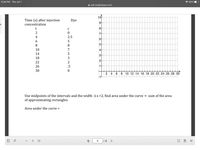
Advanced Engineering Mathematics
10th Edition
ISBN: 9780470458365
Author: Erwin Kreyszig
Publisher: Wiley, John & Sons, Incorporated
expand_more
expand_more
format_list_bulleted
Concept explainers
Question
The number of liters of blood your heart pumps in a minute is called your cardiac output.To measure a patient’s cardiac output doctors may use the dye-dilution technique (inject 5-10 mg of dye in a main vein near the heart and measure its concentration). To calculate the patient’s cardiac output, we divide the amount of dye by the area under the dye concentration curve and multiply the result by 60:Cardiac output = (amount of dye / area under the curve)×60. The table below gives dye concentration for a dye-dilution cardiac output. The amount of dye injected was 8 mg. Sketch the graph and rectangles. Shade the area of approximation. Estimate the area under the curve and calculate the cardiac output from this estimate.
Cardiac output?

Transcribed Image Text:5:24 PM Thu Jul 1
* 53% O
A cofc.brightspace.com
10
Time (s) after injection
Dye
concentration
t
8
7
4
2.5
5
8
8.
5
10
7
4
14
3
18
3
2
22
2
26
.5
30
2
4
6
8 10 12 14 16 18 20 22 24 26 28 30
-1
Use midpoints of the intervals and the width Ax=2, find area under the curve = sum of the area
of approximating rectangles.
Area under the curve =
4
| 4
Expert Solution
This question has been solved!
Explore an expertly crafted, step-by-step solution for a thorough understanding of key concepts.
This is a popular solution
Trending nowThis is a popular solution!
Step by stepSolved in 3 steps with 1 images

Knowledge Booster
Learn more about
Need a deep-dive on the concept behind this application? Look no further. Learn more about this topic, advanced-math and related others by exploring similar questions and additional content below.Similar questions
- P1.10arrow_forwardYou have a coin jar and the opening at the top has a circumference of 200.96 cm. You have a unique coin and the ratio of the area, in square centimeters, of the coin to the circumference, in centimeters, of the coin, A/C , is 17/1 . Find the circumference of the coin. Use 3.14 for . Will your unique coin fit in your coin jar?.arrow_forwardX = 2,865 μ = 2,922 ? = 81 What is Z?arrow_forward
- order: digoxin 0.75 mg po stat. how many 0.25mg tablets of this antiarythmic drug will you admnister to the patientarrow_forwardYou are asked to make a 1/3 dilution using 1.5 mL of serum. How much diluent do you need to use?arrow_forwardYour patient receives Crystodigin 0.1 mg po daily for an atrial arrhythmia. Crystodigin tablets 0.2 mg are available. How many tablets will you administer per dose?arrow_forward
- The density of seawater is about 0.001027 kg/cm³. A tropical fish tank measures 50.8 centimeters by 30.5 centimeters by 30.5 centimeters. What is the mass of the seawater in the tank? Round to the nearest hundredth if necessary.arrow_forwardMagnesium metal burns in oxygen gas to produce magnesium oxide. How many grams of magnesium oxide will be formed from 16.1 g of oxygen gas?arrow_forwardEvaluate the formula t= when u = 132, n= 13, x= 127, and s = 10 %3D t3= (Round to three decimal places as needed.)arrow_forward
arrow_back_ios
arrow_forward_ios
Recommended textbooks for you
 Advanced Engineering MathematicsAdvanced MathISBN:9780470458365Author:Erwin KreyszigPublisher:Wiley, John & Sons, Incorporated
Advanced Engineering MathematicsAdvanced MathISBN:9780470458365Author:Erwin KreyszigPublisher:Wiley, John & Sons, Incorporated Numerical Methods for EngineersAdvanced MathISBN:9780073397924Author:Steven C. Chapra Dr., Raymond P. CanalePublisher:McGraw-Hill Education
Numerical Methods for EngineersAdvanced MathISBN:9780073397924Author:Steven C. Chapra Dr., Raymond P. CanalePublisher:McGraw-Hill Education Introductory Mathematics for Engineering Applicat...Advanced MathISBN:9781118141809Author:Nathan KlingbeilPublisher:WILEY
Introductory Mathematics for Engineering Applicat...Advanced MathISBN:9781118141809Author:Nathan KlingbeilPublisher:WILEY Mathematics For Machine TechnologyAdvanced MathISBN:9781337798310Author:Peterson, John.Publisher:Cengage Learning,
Mathematics For Machine TechnologyAdvanced MathISBN:9781337798310Author:Peterson, John.Publisher:Cengage Learning,


Advanced Engineering Mathematics
Advanced Math
ISBN:9780470458365
Author:Erwin Kreyszig
Publisher:Wiley, John & Sons, Incorporated

Numerical Methods for Engineers
Advanced Math
ISBN:9780073397924
Author:Steven C. Chapra Dr., Raymond P. Canale
Publisher:McGraw-Hill Education

Introductory Mathematics for Engineering Applicat...
Advanced Math
ISBN:9781118141809
Author:Nathan Klingbeil
Publisher:WILEY

Mathematics For Machine Technology
Advanced Math
ISBN:9781337798310
Author:Peterson, John.
Publisher:Cengage Learning,

